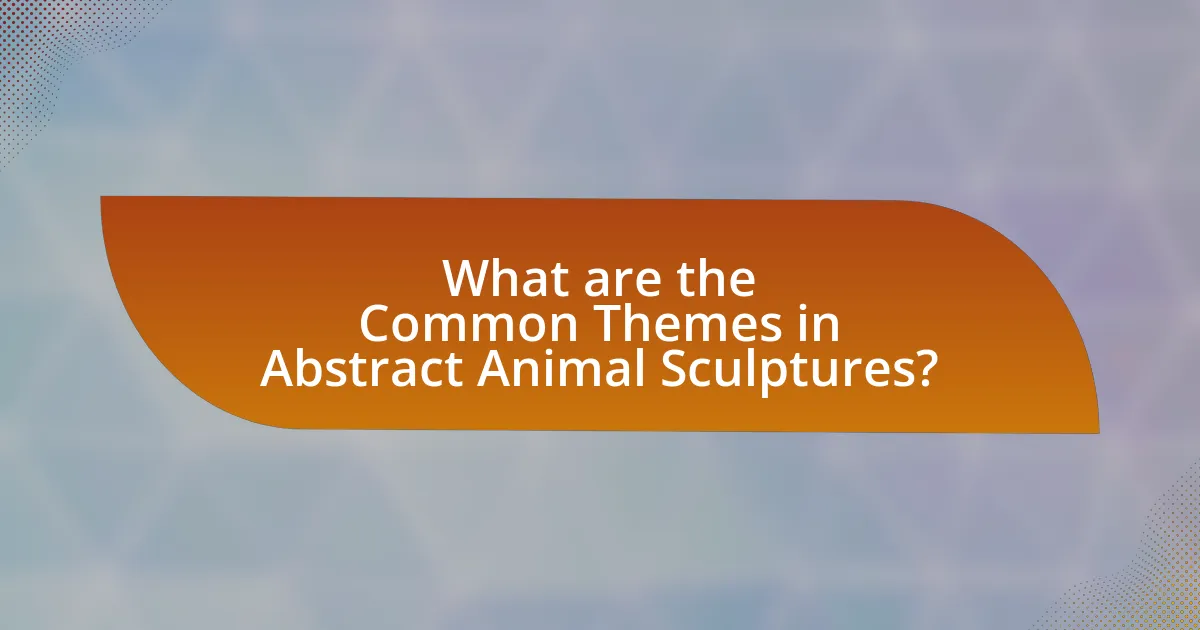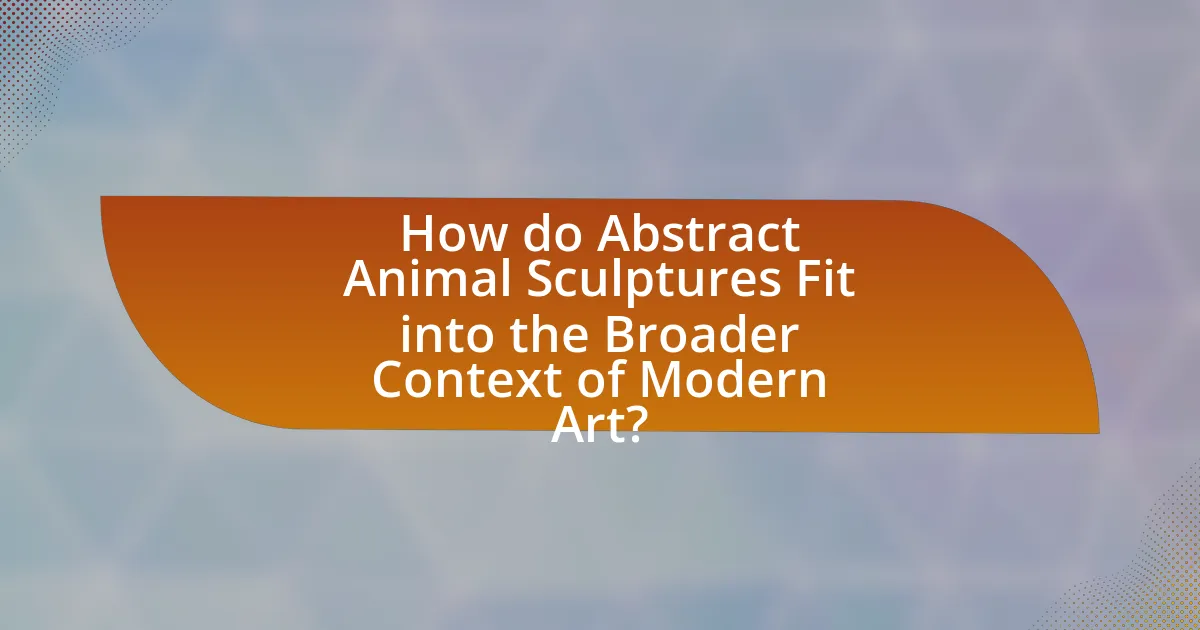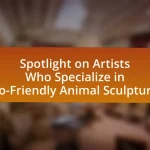Abstract animal sculptures in modern art symbolize the connection between nature and human emotion, representing themes such as instinct, freedom, and the subconscious. These sculptures utilize abstraction to evoke feelings and ideas, allowing artists to explore complex relationships between humanity and the animal kingdom. Key elements contributing to their symbolism include form, material, color, and context, which collectively shape viewer interpretation. The choice of animal significantly influences the sculpture’s meaning, reflecting cultural significance and emotional resonance. This article examines how abstract representations differ from realistic portrayals, the role of the artist’s intention, and the broader context of modern art movements that have shaped these sculptures.

What is the Symbolism Behind Abstract Animal Sculptures in Modern Art?
Abstract animal sculptures in modern art symbolize the intersection of nature and human emotion, often representing themes such as instinct, freedom, and the subconscious. These sculptures utilize abstraction to evoke feelings and ideas rather than depict realistic forms, allowing artists to explore complex relationships between humanity and the animal kingdom. For instance, the use of simplified shapes and exaggerated features can convey the essence of an animal’s spirit or behavior, reflecting the artist’s interpretation of nature. This approach aligns with movements like Surrealism and Expressionism, where artists sought to express inner experiences and emotions through distorted forms. The symbolism is further validated by the works of artists such as Henry Moore and Barbara Hepworth, who emphasized organic shapes to evoke a sense of connection to the natural world.
How do abstract animal sculptures convey meaning in modern art?
Abstract animal sculptures convey meaning in modern art by utilizing form, color, and texture to evoke emotions and ideas associated with the animal representations. These sculptures often symbolize broader themes such as nature, spirituality, or human-animal relationships, allowing artists to communicate complex concepts without relying on realistic depictions. For instance, the use of geometric shapes in an abstract representation of a bird can suggest freedom or transcendence, while the choice of materials, like metal or wood, can reflect the artist’s intention regarding the connection between humanity and the natural world. This approach aligns with the principles of modern art, which prioritize individual interpretation and emotional resonance over traditional realism.
What elements contribute to the symbolism in these sculptures?
Elements that contribute to the symbolism in abstract animal sculptures include form, material, color, and context. The form of the sculpture often distills the essence of the animal, emphasizing specific traits that evoke particular emotions or ideas, such as strength or grace. The choice of material, whether metal, stone, or wood, can also influence the interpretation, as different materials carry distinct cultural meanings; for example, bronze may symbolize permanence and nobility. Color plays a crucial role as well, with specific hues often associated with certain emotions or concepts, such as red for passion or blue for tranquility. Lastly, the context in which the sculpture is displayed can enhance its symbolic meaning, as the surrounding environment and cultural background inform the viewer’s perception. These elements collectively shape the viewer’s understanding and emotional response to the artwork, reinforcing its symbolic significance in modern art.
How does the choice of animal influence the interpretation of the sculpture?
The choice of animal significantly influences the interpretation of the sculpture by conveying specific symbolic meanings associated with that animal. For instance, a lion often represents strength and courage, while a dove symbolizes peace and purity. These associations guide viewers’ emotional responses and intellectual interpretations, shaping their understanding of the artist’s intent. Historical context also plays a role; for example, in many cultures, certain animals are linked to mythology or folklore, which can deepen the narrative conveyed by the sculpture. Thus, the selected animal not only serves as a visual element but also as a conduit for deeper thematic exploration within the artwork.
Why are animals chosen as subjects in abstract sculptures?
Animals are chosen as subjects in abstract sculptures primarily because they symbolize various human emotions, traits, and cultural narratives. The representation of animals allows artists to convey complex ideas and feelings in a visually engaging manner, often reflecting themes such as freedom, power, or vulnerability. For instance, the use of a lion can symbolize strength and courage, while a dove may represent peace and hope. This symbolic language resonates with viewers, enabling them to connect emotionally with the artwork. Additionally, abstract forms of animals can challenge perceptions and invite interpretation, making the sculptures more thought-provoking and engaging.
What cultural significance do different animals hold in art?
Different animals hold significant cultural meanings in art, often symbolizing various human traits, beliefs, and values. For instance, lions frequently represent strength and courage in Western art, while in many African cultures, they symbolize leadership and protection. Similarly, the owl is commonly associated with wisdom and knowledge across various cultures, including Ancient Greece, where it was linked to the goddess Athena. In contrast, the butterfly often signifies transformation and rebirth, reflecting themes of change in both Eastern and Western artistic traditions. These associations are rooted in historical contexts, folklore, and religious beliefs, demonstrating how animals serve as powerful symbols that convey complex ideas and emotions in artistic expressions.
How do abstract representations differ from realistic portrayals in terms of symbolism?
Abstract representations differ from realistic portrayals in terms of symbolism by emphasizing emotional and conceptual interpretations rather than direct visual accuracy. In abstract art, symbols often convey broader themes, such as freedom or spirituality, allowing viewers to engage with the artwork on a personal level, while realistic portrayals typically focus on representing the subject matter as it appears in reality, often conveying specific narratives or characteristics associated with the depicted subjects. For instance, an abstract animal sculpture may use exaggerated forms and colors to symbolize the essence of the animal’s spirit, whereas a realistic sculpture would aim to replicate the animal’s physical traits and behaviors, thus limiting the scope of its symbolic interpretation.
What role does the artist’s intention play in the symbolism of these sculptures?
The artist’s intention is crucial in shaping the symbolism of abstract animal sculptures, as it directly influences the meaning and interpretation of the artwork. Artists often embed personal, cultural, or social messages within their sculptures, which guide viewers in understanding the intended symbolism. For instance, an artist may use an abstract representation of an animal to evoke themes of freedom or confinement, reflecting their perspective on societal issues. This intentionality is supported by art theory, which posits that the creator’s context and motivations significantly affect the viewer’s experience and interpretation of the artwork.
How can an artist’s background influence their choice of animal and style?
An artist’s background significantly influences their choice of animal and style by shaping their cultural perspectives, personal experiences, and emotional connections. For instance, an artist raised in a rural environment may gravitate towards animals that symbolize nature and freedom, such as horses or birds, reflecting their upbringing and surroundings. Conversely, an artist from an urban background might choose animals that represent resilience or adaptability, like rats or pigeons, aligning with their experiences in a city landscape. Additionally, cultural heritage plays a crucial role; artists may select animals that hold specific symbolic meanings within their cultural context, such as elephants in Indian art representing wisdom and strength. This connection between background and artistic choice is evident in the works of artists like Franz Marc, who used animals to express emotional states influenced by his own life experiences and philosophical beliefs.
What techniques do artists use to enhance the symbolic meaning of their work?
Artists enhance the symbolic meaning of their work through techniques such as color symbolism, abstraction, and the use of metaphor. Color symbolism allows artists to evoke specific emotions and associations; for example, red can signify passion or danger, while blue may represent calmness or sadness. Abstraction enables artists to distill complex ideas into simpler forms, allowing viewers to interpret the work in a personal context. The use of metaphor connects the artwork to broader themes or concepts, enriching the viewer’s understanding. These techniques are evident in modern art, where abstract animal sculptures often convey deeper meanings related to nature, identity, and societal issues, thereby engaging the audience on multiple levels.
How do viewers interpret the symbolism in abstract animal sculptures?
Viewers interpret the symbolism in abstract animal sculptures as representations of various human emotions, cultural beliefs, and philosophical ideas. This interpretation arises from the use of animal forms to evoke specific traits associated with those animals, such as strength, freedom, or wisdom. For instance, a sculpture resembling a bird may symbolize freedom or aspiration, while a lion could represent courage or power. The abstraction allows for personal interpretation, as viewers project their own experiences and emotions onto the artwork. Research indicates that the emotional response to abstract art is often influenced by individual backgrounds and cultural contexts, which further shapes the symbolic meanings attributed to these sculptures.
What factors influence individual interpretations of these artworks?
Individual interpretations of abstract animal sculptures in modern art are influenced by personal experiences, cultural background, and emotional responses. Personal experiences shape how viewers relate to the themes and forms presented in the artwork, as individuals draw from their own life stories to find meaning. Cultural background plays a significant role, as different cultures may have varying associations with animals and symbolism, affecting how the artwork is perceived. Emotional responses also contribute, as the viewer’s mood and feelings at the time of viewing can alter their interpretation, leading to diverse understandings of the same piece. These factors collectively create a unique lens through which each individual engages with and interprets the artwork.
How does context affect the understanding of symbolism in modern art?
Context significantly influences the understanding of symbolism in modern art by shaping the viewer’s interpretation based on cultural, historical, and social factors. For instance, an abstract animal sculpture may symbolize different concepts depending on the cultural background of the viewer; in some cultures, certain animals represent strength or wisdom, while in others, they may symbolize fear or danger. Historical context also plays a crucial role; artworks created during periods of social upheaval may carry political or emotional weight that alters their symbolic meaning. Additionally, the artist’s intent and the environment in which the artwork is displayed can further modify its interpretation, as seen in exhibitions that provide thematic frameworks or narratives that guide viewers’ perceptions. This interplay of context and symbolism is evident in modern art movements, where the same piece can evoke diverse meanings across different audiences and settings.

What are the Common Themes in Abstract Animal Sculptures?
Common themes in abstract animal sculptures include the exploration of form, the representation of emotion, and the reflection of nature. Artists often manipulate shapes and lines to convey the essence of the animal rather than its realistic depiction, emphasizing abstraction over realism. This approach allows for a deeper emotional connection, as the sculptures can evoke feelings of freedom, power, or vulnerability. Additionally, many abstract animal sculptures symbolize broader concepts such as instinct, spirituality, or the relationship between humans and nature, reflecting cultural beliefs and values. These themes are evident in works by artists like Henry Moore and Barbara Hepworth, who utilized abstraction to express complex ideas about existence and the natural world.
How do themes of nature and humanity manifest in these sculptures?
Themes of nature and humanity manifest in these sculptures through the representation of animal forms that reflect human emotions and experiences. The abstract designs often symbolize the interconnectedness of all living beings, illustrating how human existence is influenced by natural elements. For instance, sculptures that depict animals in dynamic poses can evoke feelings of freedom and instinct, paralleling human desires and struggles. Additionally, the use of organic materials, such as wood or stone, emphasizes a return to nature, reinforcing the idea that humanity is an integral part of the natural world. This connection is further highlighted by artists who draw inspiration from ecological themes, showcasing the impact of human actions on wildlife and the environment.
What specific animals are often used to represent human traits or emotions?
Lions are often used to represent courage and strength, while owls symbolize wisdom and knowledge. Additionally, dogs are associated with loyalty and companionship, and foxes represent cunning and adaptability. These associations are rooted in cultural symbolism and folklore, where specific traits are attributed to these animals based on their behaviors and characteristics observed in nature. For example, the lion’s role as a predator and its social structure in prides contribute to its representation of bravery, while the owl’s nocturnal habits and keen eyesight have led to its association with intelligence.
How do abstract forms challenge traditional views of nature in art?
Abstract forms challenge traditional views of nature in art by distorting recognizable elements and emphasizing emotional or conceptual interpretations over realistic representation. This shift allows artists to explore themes such as the essence of nature, human perception, and the relationship between the observer and the observed. For instance, artists like Wassily Kandinsky and Piet Mondrian moved away from naturalistic depictions, instead using color, shape, and form to evoke feelings and ideas, thereby redefining how nature can be perceived in artistic expression. This approach encourages viewers to engage with art on a more subjective level, prompting them to question their preconceived notions of nature and its representation in art.
What emotional responses do abstract animal sculptures evoke?
Abstract animal sculptures evoke a range of emotional responses, including curiosity, wonder, and introspection. These sculptures often challenge viewers to interpret the forms and meanings behind the abstraction, leading to personal reflections and emotional connections. For instance, the use of exaggerated shapes and colors can elicit feelings of joy or playfulness, while more subdued or distorted forms may provoke feelings of unease or contemplation. Research indicates that abstract art, including animal sculptures, engages the viewer’s imagination and emotional faculties, allowing for a diverse spectrum of interpretations and reactions based on individual experiences and cultural backgrounds.
How do color and form contribute to the emotional impact of the sculpture?
Color and form significantly influence the emotional impact of sculpture by evoking specific feelings and associations. For instance, warm colors like red and orange can create a sense of energy or passion, while cool colors such as blue and green often evoke calmness or tranquility. The form of the sculpture, whether it is angular and sharp or smooth and rounded, also plays a crucial role; sharp forms can convey tension or aggression, while rounded forms typically suggest softness and comfort. Research in art psychology indicates that viewers often respond emotionally to these visual elements, as demonstrated in studies showing that color can alter mood and perception (Elliot & Maier, 2014, “Color and Psychological Functioning: A Review of Theoretical and Empirical Work”). Thus, the interplay of color and form in abstract animal sculptures can profoundly shape the viewer’s emotional experience.
What psychological theories explain the connection between animals and human emotions?
Psychological theories explaining the connection between animals and human emotions include attachment theory, which posits that humans form emotional bonds with animals similar to those formed with other humans, influencing feelings of love, comfort, and security. Additionally, the biophilia hypothesis suggests that humans have an innate affinity for nature and animals, leading to emotional responses that enhance well-being. Research by Hartig et al. (2014) in “Environmental Psychology” supports this, indicating that interactions with animals can reduce stress and improve mood. Furthermore, the social support theory highlights how animals provide companionship, which can alleviate feelings of loneliness and depression, as evidenced by studies showing therapy animals’ positive impact on mental health.

How do Abstract Animal Sculptures Fit into the Broader Context of Modern Art?
Abstract animal sculptures serve as a significant expression within the broader context of modern art by challenging traditional representations and exploring themes of identity, nature, and abstraction. These sculptures often utilize simplified forms and exaggerated features to evoke emotional responses and provoke thought, aligning with modern art’s emphasis on subjective interpretation and individual experience. For instance, artists like Henry Moore and Barbara Hepworth have used abstract animal forms to reflect human emotions and societal issues, demonstrating how these works can transcend mere representation to engage with deeper philosophical questions. This approach is consistent with modern art movements that prioritize innovation and conceptual depth, reinforcing the idea that abstract animal sculptures are not only aesthetic objects but also vehicles for complex symbolism and commentary on the human condition.
What movements in modern art have influenced the creation of abstract animal sculptures?
Cubism, Surrealism, and Expressionism are the primary movements in modern art that have influenced the creation of abstract animal sculptures. Cubism, pioneered by artists like Pablo Picasso and Georges Braque, deconstructed forms into geometric shapes, allowing sculptors to represent animals in fragmented, abstract ways. Surrealism, led by figures such as Salvador Dalí and Max Ernst, introduced dream-like imagery and unexpected juxtapositions, inspiring artists to explore the subconscious and create animal forms that challenge reality. Expressionism, with its emphasis on emotional experience, encouraged sculptors to convey feelings through distorted and exaggerated representations of animals, reflecting inner states rather than realistic depictions. These movements collectively shaped the evolution of abstract animal sculptures by prioritizing form, emotion, and imagination over traditional representation.
How do abstract animal sculptures reflect the principles of modernism?
Abstract animal sculptures reflect the principles of modernism by emphasizing abstraction, simplification, and the exploration of form over realistic representation. These sculptures often strip away detailed features to focus on essential shapes and lines, aligning with modernism’s rejection of traditional artistic conventions. For instance, artists like Alberto Giacometti and Henry Moore utilized abstract forms to convey emotional and conceptual depth, showcasing how modernism values individual interpretation and subjective experience over objective reality. This approach not only challenges viewers to engage with the artwork on a deeper level but also mirrors the modernist belief in innovation and the breaking of boundaries in art.
What is the relationship between abstract animal sculptures and contemporary art trends?
Abstract animal sculptures are closely linked to contemporary art trends as they often embody themes of identity, nature, and the human experience. These sculptures reflect the shift in contemporary art towards abstraction and conceptualism, where artists use animal forms to explore complex ideas and emotions. For instance, artists like Damien Hirst and Jeff Koons utilize animal imagery to comment on consumerism and the relationship between humans and nature, aligning with contemporary movements that challenge traditional artistic boundaries. This relationship is evident in exhibitions and art fairs, where abstract animal sculptures frequently appear, showcasing their relevance in current artistic dialogues.
How do these sculptures challenge traditional artistic conventions?
These sculptures challenge traditional artistic conventions by subverting realistic representation and emphasizing abstraction. Unlike classical sculptures that prioritize lifelike forms and detailed anatomy, these modern works utilize simplified shapes and exaggerated features to convey deeper symbolic meanings. For instance, the use of geometric forms in abstract animal sculptures can reflect themes of nature and instinct, moving away from the historical focus on idealized beauty. This shift not only redefines the viewer’s perception of animals but also invites interpretations that transcend mere visual aesthetics, aligning with contemporary movements that prioritize conceptual over representational art.
What are the implications of abstraction in representing animals?
Abstraction in representing animals implies a shift from realistic depictions to symbolic interpretations, allowing for diverse emotional and conceptual expressions. This approach enables artists to convey complex ideas about nature, identity, and the human-animal relationship without the constraints of literal representation. For instance, abstract animal sculptures can evoke feelings of freedom or confinement, reflecting societal issues or personal experiences. The use of abstraction also invites viewers to engage with the artwork on a more subjective level, fostering individual interpretations that can vary widely based on personal context and cultural background.
How do abstract animal sculptures redefine the viewer’s experience of art?
Abstract animal sculptures redefine the viewer’s experience of art by encouraging personal interpretation and emotional engagement. These sculptures often strip away realistic representations, allowing viewers to project their own meanings and feelings onto the artwork. For instance, the use of simplified forms and exaggerated features can evoke a range of emotions, from whimsy to contemplation, thereby transforming the interaction between the viewer and the piece. This shift in perception aligns with contemporary art movements that prioritize individual experience over traditional aesthetic values, as seen in the works of artists like Henry Moore and Barbara Hepworth, who utilized abstraction to explore themes of nature and existence.
What practical considerations should artists keep in mind when creating abstract animal sculptures?
Artists should consider material selection, structural integrity, and the intended emotional impact when creating abstract animal sculptures. The choice of materials, such as metal, wood, or clay, affects both the aesthetic and durability of the sculpture. Structural integrity is crucial to ensure that the sculpture can stand independently and withstand environmental factors, particularly for outdoor installations. Additionally, artists must think about the emotional resonance of their work; abstract representations can evoke specific feelings or ideas about the animal being depicted, influencing how viewers interpret the piece. For instance, the use of sharp angles may convey aggression, while smooth curves might suggest gentleness. These considerations are essential for creating impactful and lasting abstract animal sculptures.
What materials are best suited for conveying symbolism in these sculptures?
Bronze and stone are the materials best suited for conveying symbolism in abstract animal sculptures. Bronze allows for intricate detailing and a sense of permanence, often symbolizing strength and resilience, as seen in works like Alberto Giacometti’s “The Walking Man.” Stone, on the other hand, evokes a sense of timelessness and connection to nature, which can symbolize stability and endurance, as demonstrated in Henry Moore’s sculptures that reflect organic forms. Both materials have historical significance in art, with bronze being used since ancient times for its durability and stone representing the earth’s raw essence, thus enhancing the symbolic meanings conveyed through the sculptures.
How can artists effectively communicate their intended symbolism through form and design?
Artists can effectively communicate their intended symbolism through form and design by utilizing specific shapes, colors, and materials that evoke particular emotions or concepts. For instance, the use of sharp angles in a sculpture may convey aggression or tension, while smooth curves can suggest harmony or gentleness. Additionally, color choices play a crucial role; warm colors often evoke feelings of warmth and passion, whereas cool colors can imply calmness or detachment.
In the context of abstract animal sculptures, artists often draw on the inherent characteristics of the animals they represent. For example, a sculpture of a lion might incorporate bold, powerful forms to symbolize strength and courage, while a bird might be depicted with open wings to represent freedom. This alignment of form and symbolism is supported by art theory, which suggests that visual elements can significantly influence viewer interpretation and emotional response.
Research in art psychology indicates that viewers often rely on visual cues to derive meaning, reinforcing the importance of intentional design choices in conveying symbolism. Thus, through careful manipulation of form and design, artists can create works that resonate with their intended messages and evoke specific interpretations from their audience.


